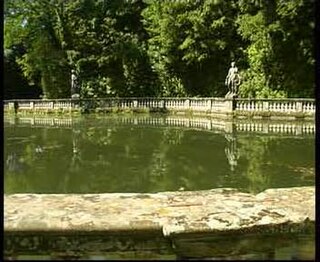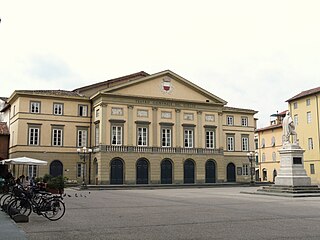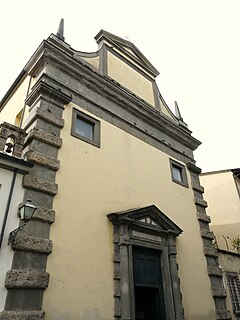
The Province of Lucca is a province in the Tuscany region of Italy. Its capital is the city of Lucca.

The Basilica of San Frediano is a Romanesque church in Lucca, Italy, situated on the Piazza San Frediano.

Stadio Porta Elisa is a multi-use stadium in Lucca, Italy. The authorized capacity is 7,386, but it can hold about 12,000; 2,500 of them are covered.

Palazzo Pfanner is a palace and a garden in Lucca, Italy, now converted into a museum of art and artifacts. The building dates to 1667, and is notable mainly for its fine garden, attributed to Filippo Juvarra, and an interesting external stairway with loggia.

Santa Cristina is a Neoclassical-style, Roman Catholic church in Pisa, region of Tuscany, Italy. It is located on the Lungarno Gambacorti.

The Italian Catholic Archdiocese of Lucca dates back as a diocese to the 1st century; it became an archdiocese in 1726. It has no suffragan dioceses, and is directly subject to the Holy See.

San Francesco is a Gothic-style, former Roman Catholic church and monastery located on piazza San Francesco in central Lucca, region of Tuscany, Italy. Since its restoration, it is now home to IMT School for Advanced Studies Lucca, a selective graduate and doctoral school.

The Ducal Palace is a palace in Lucca, Tuscany, central Italy.

Palazzo Tucci is an 18th-century palace in central Lucca, Region of Tuscany, Italy.

Villa Mansi is a country palace and gardens located in Segromigno in Monte, near Capannori, about 12 kilometers northeast of the city of Lucca in the region of Tuscany, Italy.

The Museo Nazionale di Palazzo Mansi is one of the two main art museum hosting tapestry collections and mainly post-19th century art collections owned by the city of Lucca, Italy. The collection is displayed in the Baroque palace, formerly belonging to the Mansi family, and located in central Lucca. Many of the original room decorations remain in place.

San Ponziano is a Renaissance-style, former Roman Catholic church located on a piazza of the same name in Lucca, region of Tuscany, Italy. It is now the university library for IMT Lucca.

Santa Maria Corteorlandini is a Baroque- style, Roman Catholic church located on a street of the same name in Lucca, region of Tuscany, Italy.

San Benedetto in Gottella is a Romanesque-style, Roman Catholic church located on piazza Bernardin in Lucca, region of Tuscany, Italy. The church is located on Piazza Bernardini, near the Palazzo Bernardini, on the route of the ancient decumanus maximus of Lucca.

San Pietro Somaldi is a Gothic- style, Roman Catholic church located on a Piazza of the same name, near the location of the old medieval walls, in central Lucca, region of Tuscany, Italy.

The Teatro del Giglio is the historic city theater and opera house located in Piazza del Giglio #13 and #15 in the center of Lucca, region of Tuscany, Italy.
The Palazzo Bernardini is a Renaissance palace located on the Piazza Bernardini, diagonal from the church of San Benedetto in Gotella in central Lucca, region of Tuscany, Italy.

Santissima Trinità is a Renaissance-style, Roman Catholic church in via Elisa in central Lucca, region of Tuscany, Italy.

San Cristoforo is a Romanesque and Gothic-style, former Roman Catholic church located on the narrow Via Fillungo in the center of Lucca, region of Tuscany, Italy. Now deconsecrated and stripped of its former interior altars and decoration, the chapel served as a memorial for those fallen in the wars..

San Cistoforo di Lammari is 12th-century, Romanesque-style, Roman Catholic parish church in Capannori, province of Lucca, region of Tuscany, Italy.






















